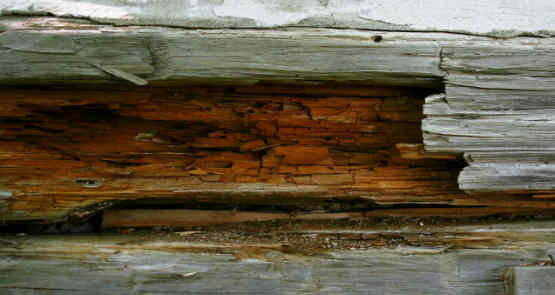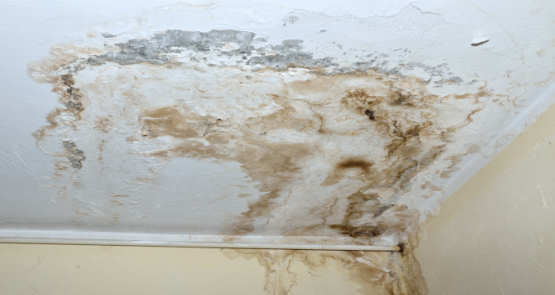Wet Rot Service Covering Plymouth, Devon & Cornwall
Wet Rot is a general term for fungus that attacks wood. There are two main types called Coniophora Puteana and Fibroporia. They both belong to the Coniophoraceae family. There are approximately twenty or so different species of fungi within the group with a vast scattering across the country. Wet rot is commonly found in buildings and is one of two chief verities of wood decaying fungi the other is Dry Rot
Any form of fungal growth needs unprotected damp timber in order to germinate. It consumes timber as its food source by breaking down the timbers cells resulting in the timber becoming very week and eventually collapsing in. Reasons for this can be from a lack of regular maintenance to the property or and original inadequate poor design build. Even though as mentioned there are twenty or so species of wet rot the most common found are Coniophora Puteana and Fibroporia Vaillantii. The treatment necessary to eliminate all and any fungal growth attack is the same. Timbers affected with wet rot appear a dark brown colour and show visible cracking down the grain.
Coniophora Puteana
Coniophora Puteana, or better known as cellar fungus, is a form of wet rot. It is classed as the most common cause of timber decay where the wood has been exposed to moisture contamination. It is not fussy and will attack softwoods and hardwoods as long as it has the right conditions. Timber that has been affected will have a yellowish colour to begin then as time goes on will darken in colour and show longitude cracks along the grain and across the grain.
Fibroporia Vaillantii
This form of wet rot is common with timber in damp environmental conditions and can cause considerable damage. It mainly prefers softwoods darkening them in colour and breaking the wood up into cuboidal sections.
General information
Unprotected timber exposed in to the elements, or in contact with wet plaster, soil or masonry in a damp environment are in jeopardy to contamination from wet rot. A common example of this is a gathering of excessive moisture on a window frame from a roof or gutter leak allowing to constantly building up with no repair programmed in. If left it will result in wet rot spores landing and germinating on the timber leading to the discoloration blackening of the window frame and eventually causing crumbling and flaking of the wood. As more and more moisture penetrates the frame it will weaken further as its cells are broken down resulting in the complete failure of the window frame.
Another form of fungal growth is White Rot. This can have a bleaching affect on wood and turning them pal. This form of rot enables the timbers to hold their shape and not crumble but will very easily crush when pressure is applied.


We tick all the boxes for wet rot treatment:
- Tailor made survey
- Accurate diagnosis
- Eliminate all fungal growth
- Renew infected timbers
- Epoxy resin repairs
- Spray fungicide biocide to the complete area
- Make good as necessary
Here at Plymouth Damp Proofing (PDP) have surveyors that will seek and identify the source of the outbreak, Investigate and locate the point of why and where such damp conditions are present in the first place, which initiated the growth. Once this has been undertaken we can reach a conclusion and offer you our diagnosis with recommendations for the correct treatment methods installations to ensure it is applied in the correct manner.
Our detailed tailor made survey will cover all other contributing possibilities and potential problems such as condensation, the correct ventilation, any water migration or ingress and any other evidence of timber decay and rot. Within our survey will be detailed information regarding the drying out and drying times for wet timbers that can be saved along with the specification requirements for the timbers than cannot be saved and need taking out and replacing.
The treatment involves the following:
- Locate and stop all leaks and places of water migration or ingress that has been causing the damp
- Perform a detailed tailor made survey covering ventilation, condensation and damp proofing
- Take out all rotted timbers that cannot be saved and renew
- Safeguard the ends of electrical conduits & exposed junction boxes inside the treatment area
- Treatment fungicidal spray of all timbers in place than can be saved
- Treatment fungicidal spray or dual-purpose fungicide or specialist timber pastes to the surrounding areas
- For historical & listed buildings the use for timber resin repairs is essential for replacement timbers
Our teams of trained engineers are multi skilled and use the correct products available to ensure the treatment of the rot and all other spores are eradicated completely preventing them from returning. The variety of wood biocides and preservatives we have at our disposal are the latest in technology delivering maximum efficiency whilst maintaining minimal levels of danger to health & safety to the environment, general public and the residents of the property.
Fungal decay is the most common cause of destruction to structural timber in buildings. It can effect any timber whatsoever from a new building with new timber to an old building with a hundred year old timber.
Fungal Decay is not bias, given the correct conditions it will thrive and is also quite common for it to spread a considerable amount before it is actually seen. As it continues to feed on the timbers in your home we may have to remove the plaster from the walls to apply a fungicide biocide agent to the masonry walls along with all the timbers.
How to deal with wet rot
Outbreaks of fungal attack require a certain environment in order to germinate so it is necessary to identify the reasons behind the fungal growth prior to addressing the fungal attack itself. Ventilation changes combined with damp problems can produce the perfect conditions suitable for the fungus to lay spores, grow and attack timber ending up in dry rot or even wet rot. The initiating factors to dry or wet rot vary greatly but it can be caused but such factors such as an internal leaky pipe, faulty leaking roofs, broken rainwater goods or insufficient ventilation. All faults should be rectified first before dealing with the dry or wet rot.
Once a detailed survey has been performed and the correct diagnosis has been made to determine if the fungi problem is dry rot or wet rot it is treated with fungicide biocide directly to all infected timbers and non infected surrounding timbers to kill and lying dormant spores. Any timber not savable will have to be replaced. Any masonry walls infected will have treatment with another very similar fungicide biocide fit for purpose with masonry to insure the problem does not return.
Wet rot can sometimes look like dry rot
Fungal rot growth can look very similar if you’re not experienced in identifying it. if you happen to see a weird bleach looking fungi growth on any wood whatsoever and if the paint on the wood is beginning to peal and flake or the wood is soft to the touch and crumbles between your fingers it may be I good idea to investigate it further with professional advice.
Wet rot and dry rot are both fungal infestations that flourish in damp environmental conditions. They can be caused by either external problem faults or internal faults.
External
External issues such as water penetration from faulty render or stone pointing. Leaking roof coverings, gutters or gullies can also play a part.
Internal
Rising damp, a slow leaking water pipe or minor leak from a radiator. No matter what the reason is, if the moisture content in timber rises above 20% it will be at risk of fungal attack.
You may be walking from the hallway to the kitchen and suddenly you foot goes through the floorboard. Oh dear! You then lift the adjacent floorboards to find this weird white stuff growing beneath the floor with a musty nasty smell. Call Plymouth Damp Proofing (PDP) for some help and expert advice.
Wet rot doesn’t spread like dry rot does. Dry rot is inclined to spread and migrate through your home via the plaster, walls, floors and ceiling in search of its food source. Where wet rot tends to prefer to stay in the vicinity of timber contaminated by the source of the damp penetration and target exposed unprotected timbers. Wet rot is much more commonly found than dry rot but if left untreated both can have a devastating effect on your home causing severe structural problems.


Spotting easy signs:
- Damp musty smell
- Floor moving & bouncing when walking upon
- Softening cracking timbers
- Discoloring of timbers
- Can see fungal growth on timbers
Wet rot is easy to spot and even though there are many species each species affects wood in a different manner. It is of the upmost importance that any outbreak of wet rot fungi is identified correctly and the source of the cause diagnosed accurately. If you are not qualified in this field the incorrect diagnosis could be potentially costly and make the situation worse.
We have had clients in the past that have found it extremely difficult recognizing the differences from dry rot to wet rot. Due to its totally destructive nature threatening the structure of a building, dry rot is classified as a serious timber destroying fungus.
As there is no pink flashing neon sigh telling exactly what it is when investigating an issue, what do you do if you come across a problem with no signs on the timber or very little signs and armed with no obvious signs leaves you with a puzzle to determine which rot it actually is.
Call Plymouth Damp Proofing (PDP) where one of our property care professional will possess the know how and knowledge to strip back and take out the wood at the rear of the decay to access the core of the problem so as they can exactly diagnose the rot species and reach the correct conclusion for the cause of decay to then stipulate the specific correct treatment to fully eradicate the problem and ensure it will not return. We have private clients in residential sectors and clients in the commercial sector so no mater what the problem is we will solve it for you.
Fixing a wet rot problem
Once the correct diagnosis and conclusions have been made you then will feel better as you now will have a plan to move forward. Wet rot is very common and usually found in the wettest rooms of your home being the bathroom, kitchen and utility rooms. It is usually less expensive to eradicate than its cousin dry rot but it may not always be an easy problem to resolve, as the first task is to locate the main source of the water penetration ingress. To resolve this first will ensure that the wet rot does not come back. Treating wet rot usually requires the treatment and or replacement of timber within the infected treatment area.
Our Warranty/Guarantee
We are proud to say we take pride in our reputation and how we work. Upon completion of our works you will receive our personal workmanship warrantee along with our guarantee and a manufactures guarantee protected and backed up by the Guarantee Protection Insurance Scheme or (GPI).
We are also looking to become members of the Property Care Association, CHAS, Construction Line and Trust Mark for your peace of mind. All our warranty and guarantees are transferable to new owners of your home if you sell your property.
What lengths of Guarantee do we offer?
- Basement water proofing treatments will receive a 10-year guarantee
- All Woodworm treatments, Dry Rot, Wet Rot and Rising Damp will receive a 30-year guarantee
- Timber unit and window treatments will receive a 5-year guarantee
- As an extra on request we can issue an independent insurance backed guarantee


Every case of damp is different and depending on the scale and size of the problem costs to repair will vary. It is important that you have your property surveyed and an individual and specific report completed as soon as possible. Our service gives each customer an individual report with recommendations and quotation to fix the damp problem. To make sure we are giving you an accurate price, one of our surveyors will come to your property to investigate the problem. Once your property has been assessed we will discuss the findings with you and detail the way forward.
Our services we supply in short:
- Damp proofing advice & support
- Damp Surveys
- Basement waterproofing
- Rising damp treatments
- Condensation treatments & control
- Woodworm Treatment
- Wet rot & dry rot treatments
Remember your property is at risk if you let damp set in and do nothing about it!
Please feel free to contact us for further advice
If you are concerned about any of the above issues affecting your property, please contact us and a member of our team will be happy to help, as we are Specialists in Property Surveying.



